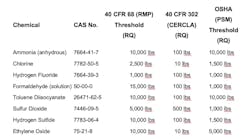Opinion: EPA and OSHA Risk Assessments Favor Certain Industries
Three Key Points
1. Regulatory Bias Toward Specific Industries
The Clean Air Act's Risk Management Plan (RMP) requirements under 40 CFR 68 create an uneven regulatory landscape that heavily burdens certain industries (petrochemical, refining, plastics, fertilizer) while providing exemptions for others. Major chemical industry sectors like petroleum refineries, petrochemical manufacturing, and basic organic chemicals manufacturing are exempt from the most stringent Program 3 requirements, creating competitive imbalances.
2. Overwhelming Notification Complexity
Companies handling chemicals face a "dizzying number of notifications" across four separate federal laws (Clean Air Act, CERCLA, EPCRA, and OSHA), each with different threshold quantities and requirements. The EPA's 206-page "List of Lists" document attempts to clarify these overlapping requirements, but the complexity has contributed to the chemical industry’s migration overseas to less-regulated jurisdictions.
3. Local Emergency Planning System Failures
State and local governments often don't know what to do with the extensive risk information provided by industries, and in some cases, "don't even care to know." Many counties have defunded their Local Emergency Planning Committees (LEPCs) or never properly staffed them since the 1986 requirements were established, creating a "sleeping hazard waiting to erupt" as demonstrated by incidents in Conyers, Georgia (2024) and East Palestine, Ohio (2023).
The future of risk assessment is here. However, it is an uneven future that is improperly weighted for large companies in specific industries. The Clean Air Act (CAA) is unbalanced and heavily tilted toward petrochemical, refining, plastics, fertilizer and other specific industries.
Tilted? Yes.
The case in point is 40 CFR 68 and CAA 112(r), which provide for Risk Management Plans (RMP) for anyone in these industries. This is compounded by the fact that state and local governments don’t know what to do with the information presented by the industries, and in extreme cases, don’t even care to know. It’s a sleeping hazard waiting to erupt in local communities just as it did in Conyers, Georgia (BioLab Incident) in 2024, and East Palestine, Ohio in 2023.
Add to that the dizzying number of notifications that anyone handling or storing chemicals must provide to the EPA. There are notification requirements under four separate laws. Several of these laws require Risk Management Plans over and above what is required by OSHA, with several requiring advanced modeling, except if you fall into certain chemical industry categories.
Is it any wonder that much of the chemical industry has fled the U.S. for less-regulated foreign shores? We need a codification of requirements and programs.
Given what follows, I believe that it is fair to coin a new set of initials for EPA programs. We are all familiar with NIMBY or Not In My Back Yard. The new acronym might be BANWEP — Build Anything Nowhere Without EPA’s Permission.
Here is a breakdown of what is required and why it is biased.
Clean Air Act
Starting with the CAA 112(r), there are listed quantities of chemicals. If an industry has more than the listed quantity in process or storage, it must prepare and file an RMP. The requirements to file an RMP are divided into three programs.
Program 1 (40 CFR 68.10 and 68.12) — If a company has more than the “threshold quantity” of a listed chemical (see 40 CFR 68.30 for the list of substances and quantities), it must do the following:
- Analyze the worst-case release scenario (WCRS) for the particular chemicals.
- Document that the nearest public receptor is beyond the endpoint.
- Provide a five-year accident history
- Ensure coordination with the local emergency planning and response agencies
- Certify that the work has been accomplished using specific wording in 40 CFR 68.12 (4) indicating no accidental releases caused offsite incidents. The language is specific and quite restrictive. The certification must be signed and dated by a corporate official (aka “The VP in charge of going to jail!”)
Program 2 is for industries that cannot provide certifications. The requirements appear more onerous, except as they apply to certain industries:
- Develop and implement a management system as provided in § 68.15; Left up to the facility.
- Conduct a hazard assessment as provided in Sec.§ 68.20 through § 68.42.
- Implement the Program 2 prevention steps provided in Sec.§ 68.48 through§ 68.60 or implement the Program 3 prevention steps provided in Sec.§ 68.65 through § 68.87.
- Develop and implement an emergency response program as provided in Sec.§ 68.90 to 68.95.
- Submit as part of the RMP the data on prevention program elements for Program 2 processes as provided in § 68.170.
Details are important. Here is what’s in 40 CFR 68.20:
The EPA has specified specific release conditions and weather conditions for modeling a release scenario. They include endpoints for toxic chemicals, detailed modeling conditions, defined release quantities and rates and radiation endpoints (5 kw/M2 for 40 seconds), an overpressure of 1 psig, release height, gas buoyancy if appropriate and temperature of release. If a flammable liquid is released, it must be assumed that it results in an explosion. (40CFR 68.25)
Note that this is for each chemical involved. EPA’s ALOHA suite can be of some assistance, but the downwind modeling distance only goes out to six miles, which is inadequate in the case of a large toxic release. Additional modeling using the colored books or another acceptable modeling program may be required.
Program 3 — According to the North American Industry Classification System (NAICS), these industries are exempt: pulp mills, petroleum refineries, petrochemical manufacturing, alkalies manufacturing, most inorganic chemicals manufacturing, all basic organic chemicals manufacturing, plastics materials and resins manufacturing, nitrogenous fertilizer manufacturing, and pesticide and other agricultural chemical manufacturing or if the processes are covered by OSHA PSM (29 CFR 1910.119). Operations on the Outer Continental Shelf (40 CFR 55.2) are also exempt from Program 3, as are those companies that meet the injury, fatality and lack of offsite receptor damage provisions and timing for Program 1.
Program 3 appears to be a major exemption, but is it? The RMP under the CAA must be registered with the EPA, providing very complete information required under 68.160.
EPCRA Fills in The Gaps
Under the Emergency Planning and Community Right-to-Know Act (EPCRA) of 1986, there is another list of Extremely Hazardous Substances and Threshold Chemical Quantities list that requires any facility having in excess of the planning quantities threshold to provide information to the local community emergency planning committees.
Sections of 355 define who is covered and how to determine if one is covered:
§355.14 defines aggregation requirements for chemicals.
§355.15 defines the quantities for threshold determination.
§355.16 defines different states of materials for threshold determination.
§355.20 tells the industry what must be reported, who to report it to, and when.
§355.31 defines exempted releases that generally fall into specific categories.
- Releases solely within the plant boundaries
- Federally permitted releases under CERCLA §101.10
- Radionuclides
- Nitrogen Oxides, or NO2 from combustion under 1,000 lb/24 hours
- Air emissions from animal waste
There is a table in Section 302.4 that has the listing of the chemicals and quantities.
Clarification and the List of Lists
The EPA has attempted to clarify the notification requirements in a 206-page List of Lists document. It has categories listing quantities regulated under the Clean Air Act, CERCLA, Clean Water Act, EPCRA, and EPCRA Section 313 (TRI), and it has a column of applicable RCRA Codes. There are between 20 and 30 chemicals listed per page.
No, I can’t blame you if you are confused just by looking at the requirements.
EPCRA Section 313
This section states the requirements for certain manufacturing, processing or facilities using listed toxic chemicals to report the annual quantity of such chemicals entering each environmental medium. These facilities must also report pollution prevention and recycling data for such chemicals, pursuant to section 6607 of the Pollution Prevention Act, 42 U.S.C. 13106.
EPCRA Section 313 established an initial list of toxic substances that comprised more than 300 chemicals and 20 chemical categories. EPCRA Section 313 currently requires reporting on over 600 chemicals and chemical categories.
If you are confused, you are not alone. The EPA List of Lists helps simplify some of the notification requirements.
Here is a brief example of some of the programs simplified to exclude EPCRA and the Clean Water Act.
Elements of Process Safety Management (PSM) under OSHA
- Employee Participation – Workers must be involved in PSM program development and implementation.
- Process Safety Information (PSI) – Maintain detailed info on hazards, technology, and equipment.
- Process Hazard Analysis (PHA) – Identify and analyze potential hazards using methods like HAZOP or What-If.
- Operating Procedures – Written steps for normal and emergency operations.
- Training – Employees must be trained initially and periodically.
- Contractors – Ensure contractors are qualified and follow safety protocols.
- Pre-startup Safety Review (PSSR) – Conducted before introducing hazardous chemicals to new or modified systems.
- Mechanical Integrity – Maintenance, inspection and testing of critical equipment.
- Hot Work Permit – Procedures and permits required for welding or cutting in hazardous areas.
- Management of Change (MOC) – Review of any changes to chemicals, technology, equipment or procedures.
- Incident Investigation – Root cause analysis of incidents within 48 hours.
- Emergency Planning and Response – Onsite emergency response plans aligned with local responders.
- Compliance Audits – At least every three years to evaluate compliance.
- Trade Secrets – Employees must have access to necessary safety information even if proprietary.
As mentioned, the EPA has placed a burden on industry, but it is substantially less on segments of the chemical industry that “qualify” for Program 2 and Program 3.
SEPCs and LEPCs
The EPA and OSHA have regulatory authority that requires the preparation of inventory evaluations, development of release scenarios, preparation of emergency response plans, filing of these reports and plans within individual community Local Emergency Planning Committees, and periodic updating of those plans. The EPA is using the EPCRA as a vehicle for this requirement, and OSHA is using PSM regulations as its vehicle.
EPCRA Section 301 establishes the requirements for state and local emergency planning districts and planning committees. There is even a handbook for LEPCs. The requirements were established in 1986. The LEPCs must develop an emergency response plan, assess their response capabilities, evaluate their resource needs, conduct either a tabletop or a full-scale exercise, and keep their plans updated.
One significant problem is that counties have largely ignored the requirements. In more than one case, the counties have defunded the LEPC, and in other cases, the LEPCs have never really been staffed to comply with their requirements.
It may be time to rethink and codify the notification requirements. This is important if the chemical industry is to be rebuilt and returned to the U.S. Tariffs can only do so much to help the U.S. industry grow back to where it was as a world powerhouse.
About the Author
David L. Russell
David is president of Global Environmental Operations, Inc. He is an experienced environmental/chemical engineer and has written on various subjects, including remediation, water and wastewater treatment, sampling and sustainability. He lectures and works in various parts of the world.


